
WHY THIS MATTERS IN BRIEF
Ears are often overlooked as a place to shove a computer into but as computing and sensor technologies become smaller and more sophisticated the researchers have a good point.
 Love the Exponential Future? Join our XPotential Community, future proof yourself with courses from XPotential University, connect, watch a keynote, or browse my blog.
Love the Exponential Future? Join our XPotential Community, future proof yourself with courses from XPotential University, connect, watch a keynote, or browse my blog.
As a regular reader of my blog I know you’ve heard of wearable computing, and most definitely you’ve heard about biological, chemical, DNA, liquid, and quantum computing – obviously. But, have you heard about Earable Computing? Probably not because up until this week even though the concept makes sense I hadn’t heard of it either, although I did just write an article on a set of new earbuds that can hack and zap your brain, but for now that’s a separate thing …
Now though it too seems to be a thing after CSL’s Systems and Networking Research Group (SyNRG) defined a new sub-area of mobile technology that they call, you guessed it, “Earable Computing.” The team believes that earphones will be the next significant milestone in wearable devices, and that new hardware, software, and apps will all run on this platform.
“The leap from today’s earphones to ‘earables’ would mimic the transformation that we had seen from basic phones to smartphones,” said Romit Roy Choudhury, professor in electrical and computer engineering (ECE). “Today’s smartphones are hardly a calling device anymore, much like how tomorrow’s earables will hardly be a smartphone accessory.”
Instead, the group believes tomorrow’s earphones will continuously sense human behaviour, run acoustic augmented reality, have Alexa and Siri whisper just-in-time information, track user motion and health, and offer seamless security, among many other capabilities.
The research questions that underlie earable computing draw from a wide range of fields, including sensing, signal processing, embedded systems, communications, and machine learning. The SyNRG team is on the forefront of developing new algorithms while also experimenting with them on real earphone platforms with live users.
Computer science PhD student Zhijian Yang and other members of the SyNRG group, including his fellow students Yu-Lin Wei and Liz Li, are leading the way. They have published a series of papers in this area, starting with one on the topic of hollow noise cancellation that was published at ACM SIGCOMM 2018. Recently, the group had three papers published at the 26th Annual International Conference on Mobile Computing and Networking (ACM MobiCom) on three different aspects of earables research: facial motion sensing, acoustic augmented reality, and voice localization for earphones.
“If you want to find a store in a mall,” says Zhijian, “the earphone could estimate the relative location of the store and play a 3D voice that simply says ‘Follow me.’ In your ears, the sound would appear to come from the direction in which you should walk, as if it’s a voice escort.”
The second paper, EarSense: Earphones as a Teeth Activity Sensor, looks at how earphones could sense facial and in-mouth activities such as teeth movements and taps, something that resembles MIT’s most recent “mind reading” gadget that lets you use your jawbone to search Google, that would enable hands-free communication with smartphones – as well as possibly, for all you privacy geeks, finally letting you talk silently in public while the gadget translates your mouth movements into sound that the other person on the other end of the phone could hear.
Moreover, various medical conditions manifest in teeth chatter, and the proposed technology would make it possible to identify them by wearing earphones during the day. In the future, the team is planning to look into analyzing facial muscle movements and emotions with earphone sensors.
The third publication, Voice Localization Using Nearby Wall Reflections, investigates the use of algorithms to detect the direction of a sound. This means that if Alice and Bob are having a conversation, Bob’s earphones would be able to tune into the direction Alice’s voice is coming from.
“We’ve been working on mobile sensing and computing for 10 years,” said Wei. “We have a lot of experience to define this emerging landscape of earable computing.”
So will earable computing be a thing in the future? Well, it’s actually highly likely given the fact that today you can already buy earphones with inbuilt heart rate sensors and so on, and as technology and sensors continue to get more sophisticated and smaller we’ll be able to embed more and more tech into the tiny things that we embed in our ears …
















Would love to communicate with this crew. At Apollo 13 Designs, LLC we are already there with regard to our IP (patented) regarding “covert talking” communication utilizing the combination of our “EarAid” and the touch/swipe technology of our wearable ring. We are enrolled in the DoD Tech Warrior Program at Wright-Patterson AFB and I can be reached at mike@musering.com 717-742-8331 anytime. Mike